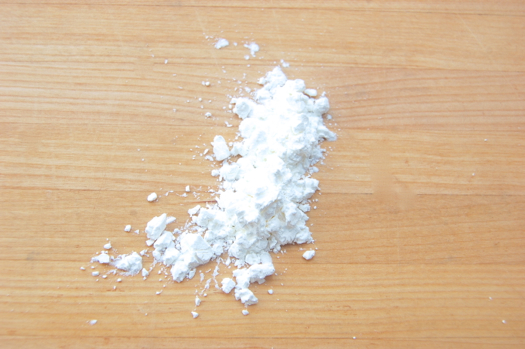Cornstarch (Corn Flour)

Cornstarch is, obviously, a starch thickener which means it thickens much the same way wheat flour does: with tangles of long-chain sugars that slow down the flow of the water around them. However there are several important differences between wheat flour and corn starch. One of those is particle size. Cornstarch is milled much finer than wheat flour, which means when those particles come in contact with hot water, they begin to shed starch molecules much faster. So cornstarch thickening happens faster than wheat flour thickening, but then also “un-thickens” that much faster.
Still the advantages of the very small particles are legion. Small as they are they don’t register on the tongue in liquid so cornstarch-thickened liquids have no cereal texture or aftertaste, even when cooked for only a short period of time. The smaller particles also allow more light rays to pass through the mixture, which gives cornstarch-thickened liquids a glossy and only faintly cloudy — or even totally clear — appearance.
Cornstarch is especially good at thickening dairy, though the higher the acidity of the liquid you’re trying to thicken, the weaker a cornstarch gel will become. Like wheat flour gels, cornstarch gels don’t hold up well after they’re frozen.
The best way to apply cornstarch to a mixture is to make a paste out of it first, using a roughly equivalent amount of cold water (which prevents any unwanted pre-gelling). When it boils it’s as thick as it’s going to get.
Because cornstarch is a pure starch, with no protein or other substances in it, it has double the thickening power of wheat flour.
I mostly use cornstarch when I’m making blueberry pie, and there’s no water in the recipe, though there is lemon juice. Could I improve the thickening by making a paste with the lemon juice? Or with a little uncalled for water? Or just toss it in there like usual? I don’t always have a thickening problem with my pies, but it does happen and it’d be nice to have a foolproof plan.
Hi Amanda!
The same thing happens to me from time to time: the cornstarch clumps and fails to thicken very well. So I generally spit the difference and toss the fruit in a cornstarch slurry, then I sprinkle a tad on the top of the filling for good measure!
Cheers,
– Joe
Wonder about tapioca here. We use it in pies as a thickener, at our churchs “Freezer Sale”. Last year, while making, we ran out & I went to the store to pick some up and was met with confusion over the different types. I would think as a pie thickener you would not want the “pearl” type of tapioca but that seems to be the most commonly available. I’ve heard of, but not seen, tapioca flour.
What is the best tapioca item for pie thickening? Can I “blitz” pearl tapioca in a food processor to make tapioca flour…similar to making almond flour? I live in South Central Pennsylvania, home to PA Dutch, Amish & Mennonite, but I’m originally from Los Angeles so I have run into many cultural/location differences over the years. argh
Thanks for your assist.
Janice
Hi Janice!
Tapioca flour is what you want and it does work well for pie. My guess is that it would be very difficult if not impossible to grind pearl tapioca finely enough to use it as a thickener. Corn starch is a great pie filling thickener as well in absence of tapioca flour, and it’s usually easy to find….at least here in the States!
Cheers,
– Joe
Asian grocery stores (cheapest), random bulk bins (second-cheapest, and you can get smaller amounts), and Bob’s Red Mill aisles (…not so cheap) have been where I’ve found tapioca flour. I should add the warning, however, that it is *strong* stuff and can turn things super-gummy if you try to, say, substitute it tablespoon-for-tablespoon for instant tapioca in recipes. In my opinion, though, once you’ve got the hang of it, it’s unsurpassed for most baked-fruit-filling thickening needs. It’s worth asking around (not sure if PA Dutch baking ever uses it… but there are some surprising ingredients commonly used!) or checking over all the white-powder-bulk-bin labels.
Thanks, KC!
– Joe